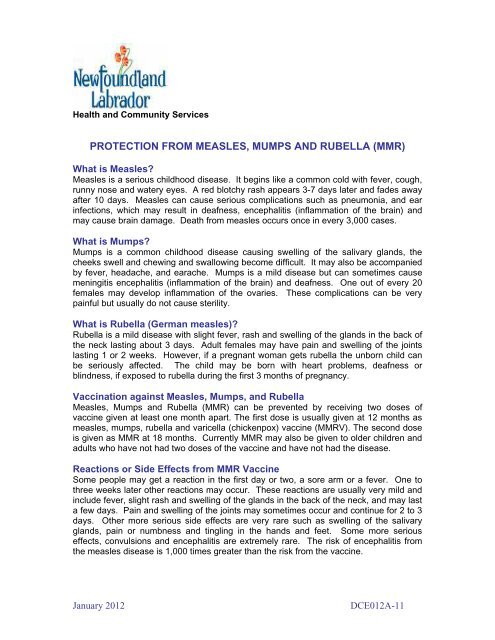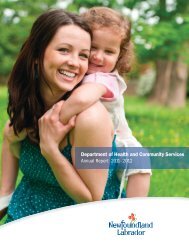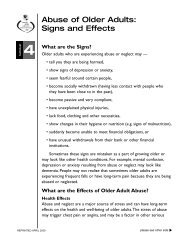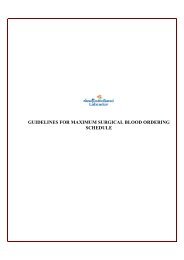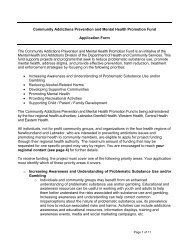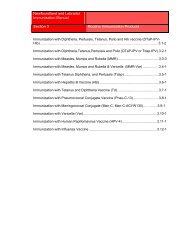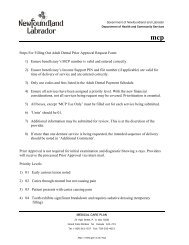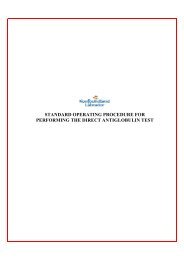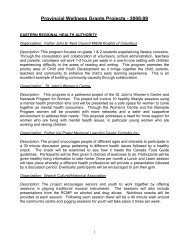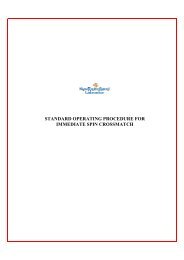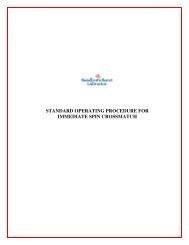PROTECTION FROM MEASLES, MUMPS AND RUBELLA (MMR)
PROTECTION FROM MEASLES, MUMPS AND RUBELLA (MMR)
PROTECTION FROM MEASLES, MUMPS AND RUBELLA (MMR)
Create successful ePaper yourself
Turn your PDF publications into a flip-book with our unique Google optimized e-Paper software.
Health and Community Services<strong>PROTECTION</strong> <strong>FROM</strong> <strong>MEASLES</strong>, <strong>MUMPS</strong> <strong>AND</strong> <strong>RUBELLA</strong> (<strong>MMR</strong>)What is Measles?Measles is a serious childhood disease. It begins like a common cold with fever, cough,runny nose and watery eyes. A red blotchy rash appears 3-7 days later and fades awayafter 10 days. Measles can cause serious complications such as pneumonia, and earinfections, which may result in deafness, encephalitis (inflammation of the brain) andmay cause brain damage. Death from measles occurs once in every 3,000 cases.What is Mumps?Mumps is a common childhood disease causing swelling of the salivary glands, thecheeks swell and chewing and swallowing become difficult. It may also be accompaniedby fever, headache, and earache. Mumps is a mild disease but can sometimes causemeningitis encephalitis (inflammation of the brain) and deafness. One out of every 20females may develop inflammation of the ovaries. These complications can be verypainful but usually do not cause sterility.What is Rubella (German measles)?Rubella is a mild disease with slight fever, rash and swelling of the glands in the back ofthe neck lasting about 3 days. Adult females may have pain and swelling of the jointslasting 1 or 2 weeks. However, if a pregnant woman gets rubella the unborn child canbe seriously affected. The child may be born with heart problems, deafness orblindness, if exposed to rubella during the first 3 months of pregnancy.Vaccination against Measles, Mumps, and RubellaMeasles, Mumps and Rubella (<strong>MMR</strong>) can be prevented by receiving two doses ofvaccine given at least one month apart. The first dose is usually given at 12 months asmeasles, mumps, rubella and varicella (chickenpox) vaccine (<strong>MMR</strong>V). The second doseis given as <strong>MMR</strong> at 18 months. Currently <strong>MMR</strong> may also be given to older children andadults who have not had two doses of the vaccine and have not had the disease.Reactions or Side Effects from <strong>MMR</strong> VaccineSome people may get a reaction in the first day or two, a sore arm or a fever. One tothree weeks later other reactions may occur. These reactions are usually very mild andinclude fever, slight rash and swelling of the glands in the back of the neck, and may lasta few days. Pain and swelling of the joints may sometimes occur and continue for 2 to 3days. Other more serious side effects are very rare such as swelling of the salivaryglands, pain or numbness and tingling in the hands and feet. Some more seriouseffects, convulsions and encephalitis are extremely rare. The risk of encephalitis fromthe measles disease is 1,000 times greater than the risk from the vaccine.January 2012DCE012A-11
Some people should not receive the <strong>MMR</strong> vaccine. If you/your child has any of thefollowing please check with the doctor or public/community health nurse:Sick with fever or infectionAllergic reaction (hives, swelling of the face, lips or throat; wheezing; shock;anaphylaxis) to neomycin or to a previous dose of measles vaccineCancer, leukemia, lymphomasReceiving treatment with steroidsRecently received immune globulin (IG) or other blood productsPregnancyFor additional information and servicescontact your Regional Health Authoritylisted in the white pages of yourtelephone book.January 2012DCE012A-11


